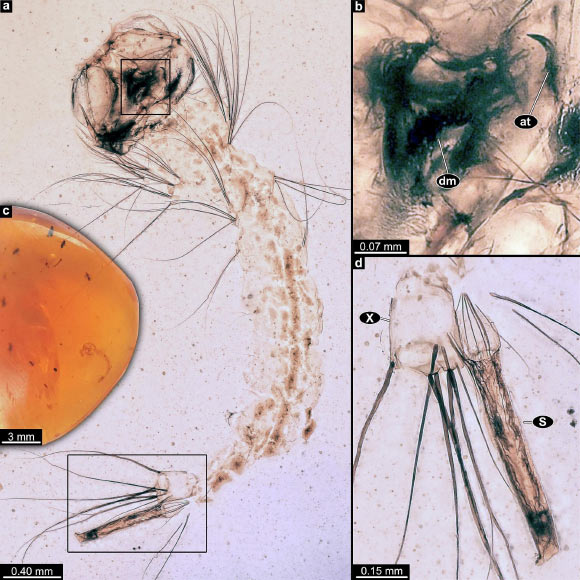The new fossil, encased in a piece of amber from the Kachin region of Myanmar, represents both the first mosquito larva preserved in amber and the first immature mosquito from the Mesozoic Era, named as a new genus and species Cretosabethes primaevus. This discovery provides strong support for the Jurassic origin of the mosquito family Culicidae and suggests that their larval morphology has remained relatively conserved for at least the past 99 million years.
The mosquitoes comprise a large group of insects, with over 3,727 living species.
Despite their small body size, they are highly conspicuous and widespread, playing a significant role in ecosystems, human history, and human and veterinary health.
Currently, 31 fossil species of mosquitoes are recognized. Ancient mosquitoes are similar to living species and have been placed in genera with living representatives.
“These oldest known mosquito fossils come from adult insects and were also found in amber deposits around 99 million years old,” said Dr. André Amaral of the Ludwig-Maximilians-Universität München and colleagues.
“Due to their morphology, which differs sharply from that of modern species, they are interpreted as representing a distinct group, Burmaculicinae, an extinct lineage within Culicidae.”
According to the authors, Cretosabethes primaevus belongs to the Sabethini group, which includes living species.
Like the larvae of living Sabethini species, the larva of the new species is thought to have lived in small accumulations of water.
“The evolutionary origins of mosquitoes have been situated in the Jurassic period around 201-145 million years ago, based on the fossils that have been found to date,” they said.
“Estimates based on molecular phylogenies widely diverge and yield results between the Triassic and the Jurassic.”
“Our results provide strong indications that mosquitoes had already diversified in the Jurassic period and that the morphology of their larvae has remained remarkably similar for almost 100 million years.”
“This calls into question previous assumptions about the early evolution of this insect group and affords new insights into its evolutionary ecology.”
The piece of amber containing the fossil larva of Cretosabethes primaevus comes from Kachin amber mines in the Hukawng Valley, Kachin state, Myanmar.
These deposits date from the Late Cretaceous epoch at 98.79 million years ago.
“This fossil is unique, because the larva is very similar to modern species — in contrast to all other fossil discoveries of mosquitoes from this period, which exhibit highly unusual morphological traits that are no longer present in today’s species,” Dr. Amaral said.
A paper describing Cretosabethes primaevus was published this month in the journal Gondwana Research.
_____
André P. Amaral et al. 2025. First fossil mosquito larva in 99-million-year-old amber with a modern type of morphology sheds light on the evolutionary history of mosquitoes (Diptera: Culicidae). Gondwana Research 150: 154-162; doi: 10.1016/j.gr.2025.09.011








